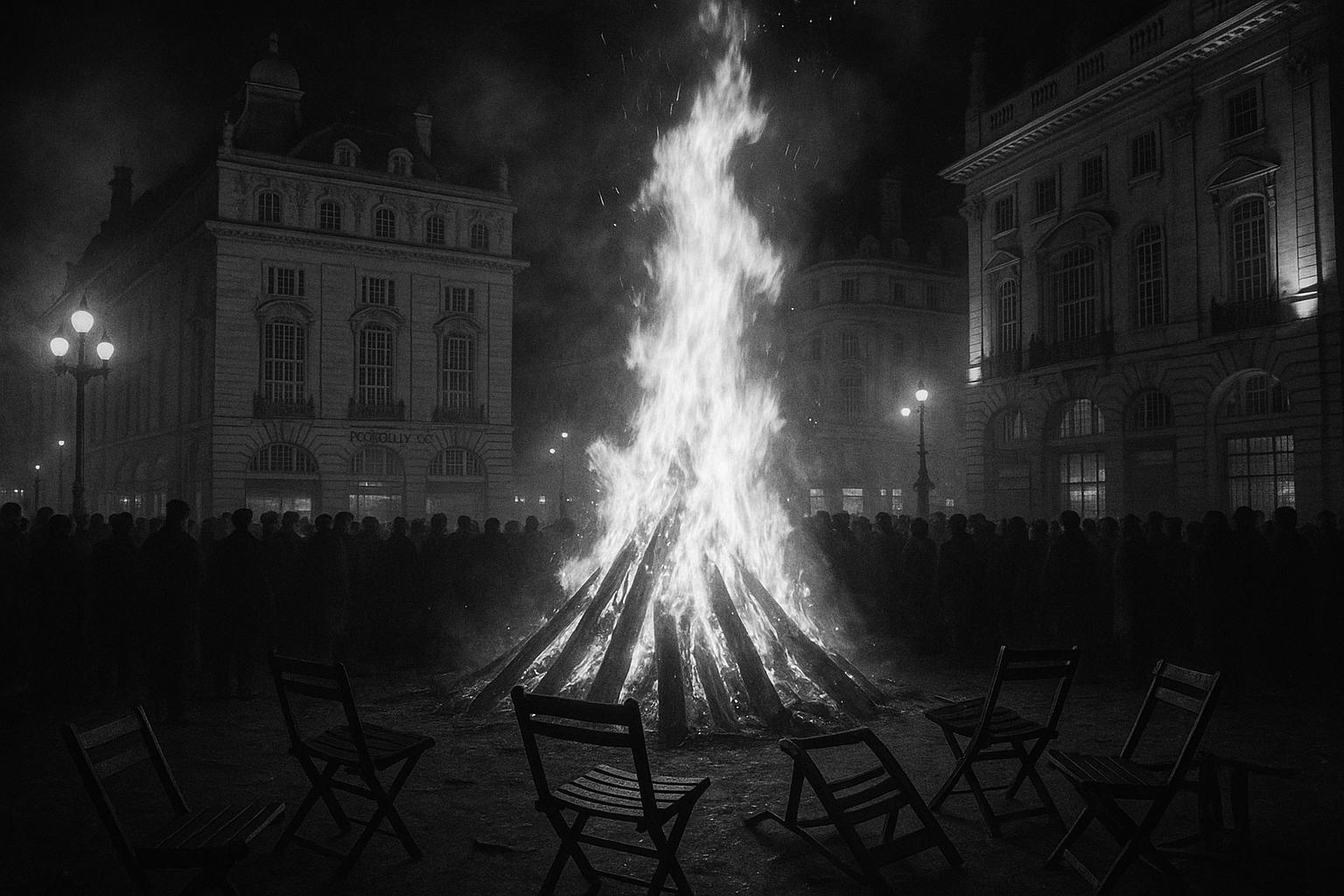It was, by eyewitness and archival account, one of the loudest nights London has ever known. On 15 August 1945 vast, exuberant crowds poured into Piccadilly Circus, Trafalgar Square and the streets around Buckingham Palace to celebrate the public announcement that Japan had capitulated, bringing six years of global conflict to an end. Contemporary photographs and rare colour film preserved in national collections capture servicemen and civilians dancing in the streets, bonfires blazing in thoroughfares and landmark buildings floodlit against the night sky — a spontaneous outpouring of relief and joy after half a decade of hardship. According to the Imperial War Museums and contemporaneous press reporting, the scenes were immediate, improvised and overwhelming in scale.
The rejoicing was not without excess or consequence. Newspaper reports the following day described bonfires stoked with park chairs and traffic smothered by people on roofs and running‑boards; there were dozens of injuries from fireworks and crushes and St John Ambulance and the Red Cross were kept busy treating burns, fainting and trampling casualties. The official photographic record likewise shows street furniture overturned and crowds clustered around makeshift fires, while filmed footage gives an impression of the sheer density of bodies and the disorder that accompanied the celebrations. Yet amid the damage and disruption the prevailing mood remained one of incandescent relief.
The royal family stepped into that public moment. Large congregations massed outside Buckingham Palace and, in the days that followed, the King and his family greeted crowds from the palace balcony and took part in a thanksgiving service at St Paul’s Cathedral. The rejoicings coincided with the State Opening of Parliament — a reminder that public celebration and formal state ritual were happening side by side. Contemporary newspapers carried pictures of the King, Queen and their daughters and described the balcony scenes as a focus for popular gratitude.
That gratitude was tinged with solemnity in the King’s own words. In his broadcast marking VJ Day, King George VI paid tribute to the armed forces of the United Kingdom, the Dominions and the wider Commonwealth and urged the nation to remember those who had died and the suffering of prisoners and occupied peoples. “The war is over,” he said — words he told listeners were “simple yet immense” in meaning for the royal household and the public alike — and he appealed for thanksgiving coupled with a steady resolve to shoulder the long work of reconstruction. The text of that broadcast and the State Opening speech are preserved in the royal record and parliamentary transcripts.
The immediate cause of the surrender — and much of the historical debate that surrounds it — lay in the closing campaigns in the Pacific. Contemporary coverage and later historical summaries note that the announcement of Japan’s intention to surrender followed the atomic bombings of Hiroshima and Nagasaki and the entry of Soviet forces into the war against Japan; the formal surrender ceremony, however, did not take place until 2 September 1945 aboard the battleship USS Missouri. Archival curators and broadcasters alike emphasise the distinction between the public moment of VJ Day on 15 August and the legal, ceremonial end of hostilities some weeks later.
Estimates of the human cost underline why the relief was so profound and why remembrance accompanied rejoicing. Press accounts at the time underlined the scale of British sacrifice over six years; figures for deaths and casualties in the Far East vary between sources and compilations. Contemporary reporting referred to hundreds of thousands of British service deaths overall and to tens of thousands lost in the Far East theatre, while later tabulations of Commonwealth and British losses — assembled by historians and collated in public reference works — present different totals and emphasise the heavy toll among prisoners of war and civilian populations in Asia. In short, the numbers vary by source, but the shared reality is of profound and enduring loss.
The scenes of celebration were not confined to London. Across the country towns and port cities celebrated: Dover’s castle was floodlit for the first time since 1939, seaside resorts filled with dancing holiday‑makers, naval ports staged searchlight displays and fireworks, and industrial cities hosted jubilant crowds despite rain and transport shortages. Photographs and local reports from the period show similar patterns of spontaneous street dancing, disrupted services and makeshift commemorative fires, reinforcing that VJ Day was experienced as a national, not merely metropolitan, moment.
Even as people celebrated, political leaders urged sober reflection. Prime Minister Clement Attlee’s radio broadcast thanked the armed services and asked the public to return to peacetime tasks with renewed energy; the King’s speech warned that the consequences of war would be felt long after the rejoicing had died down. The archival record — from press pages to official transcripts and film — therefore presents VJ Day as a complex moment: ecstatic, noisy and communal, but also conscious of sacrifice and the long responsibilities of peace.
📌 Reference Map:
##Reference Map:
- Paragraph 1 – 1, 2, 3, 6
- Paragraph 2 – 1, 6, 2
- Paragraph 3 – 1, 6, 4
- Paragraph 4 – 4, 5
- Paragraph 5 – 3, 2
- Paragraph 6 – 1, 7
- Paragraph 7 – 1, 6, 3
- Paragraph 8 – 1, 4, 5
Source: Noah Wire Services
